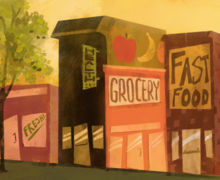LGBT issues gain awareness on Syracuse University campus as Resource Center celebrates 15-year anniversary
Daily Orange File Photo
Tiffany Gray, director of the LGBT resource center, said she hopes Syracuse University will eventually be a campus in which all of the spaces that support marginalized communities are truly integrated.
The Syracuse University LGBT Resource Center has stood at 750 Ostrom Ave. for 15 years. Some years a rainbow flag can be seen hanging from its entrance, but some years it’s been taken down.
Tiffany Gray, the director of the resource center, said while the flag can mean pride and visibility, it can also be a source of tension. Many people have expressed feeling unsafe or conflicted about walking to the center when the flag is hanging, Gray said. Acts of vandalism have occurred at the center, and Gray said she sometimes worries the flag can become a target.
“Just because we’re not reading things daily in public safety news alerts, that doesn’t mean things aren’t happening to students individually or systemically,” Gray said.
For 15 years, the resource center has been counteracting these issues and working to foster a safer campus through education, advocacy and outreach. The center is guided by its core values of accountability, awareness, community and social justice. Looking back at its years of service, Gray said she is proud of how deeply embedded the core values are in everything they’ve done.
“The complexity in thinking has grown at the center,” Gray said. “There hasn’t been a time where we weren’t trying to be as inclusive, thoughtful, complex and dynamic as possible.”
Looking to the future, Gray said a goal of the resource center’s is to assess the accessibility and visibility of their current location. They would like to improve the accessibility for students with limited mobility, she added.
Gray said she hopes to one day see a campus where the all of the spaces that support marginalized communities are truly integrated.
“People view our work as foundational to people who identify as LGBTQ, but I hope they can begin to recognize that everyone has a part to play in the liberation of all people,” Gray said.
During her freshman year, Morgan Elizabeth, a Syracuse University senior, began to accept and understand her bisexuality. Though she knew about the resource center at the beginning of the year, it took her until mid-semester to make her way there.
“I went in crying, and I was like ‘Oh my god I’m bisexual. This is who I am, and the community’s not going to accept me,’” Elizabeth said.
Gray was at the center to welcome and support Elizabeth. Elizabeth said it was crucial for her to enter a physical LGBT community space and see healthy, happy queer people. She was given the resources to learn about and join the SU LGBT community, and has also found supportive online communities.
Elizabeth said she is still learning to fully accept her sexuality. She said she can often feel pressure from within the LGBT community to “pick a side” or to be “out and proud.”
Margaret Himley, associate provost for international education and engagement, and professor of writing and rhetoric, said Elizabeth’s experience can be very common within the LGBT community.
This occurrence of “homonormativity” can permeate the idea that there is a version of homosexuality that is acceptable, Himley said. People often think of the cisgendered, homonormative couple living in the suburbs, and this idea can leave some queer people on the outside.
“It’s one of the resource center’s job to make sure people feel welcomed, and this can be a lot more complicated than people understand,” Himley said.
Himley is also the co-director of the LGBT studies program, and was instrumental in creating and implementing the LGBT studies minor in 2006.
When courses were initially offered, Himley said they were not made up of primarily LGBT students. She said students often had a real passion for LGBT studies, and either knew somebody or had LGBT family members.
“There was this really intense nexus of lived life and scholarship,” Himley said.
Andrew London, a sociology professor, worked alongside Himley and others in establishing the LGBT studies minor. He taught courses within the minor, and said part of teaching these courses is understanding how to manage “political moments” when they emerge in the classroom.
People come from different communities and families, London said, and can be at very different levels in terms of understanding the issues and sensitivities surrounding the LGBT community. He said he’s enjoyed watching students change and progress in their views after discussing them with the class and receiving feedback.
“You’re not trying to dictate people’s thoughts, but you are trying to shape them, influence them or encourage them to rethink something for themselves,” London said.
London said one of the most important functions of the resource center is that it’s a space on campus that the LGBT community can claim ownership of. The resource center is part of creating a campus environment where difference is recognized and valued, he added.
“It creates a possibility to do something different or to undo some of the discrimination and hate that happens out there in the world,” London said.
Published on September 27, 2016 at 1:16 am
Contact Lydia: lawilson@syr.edu





